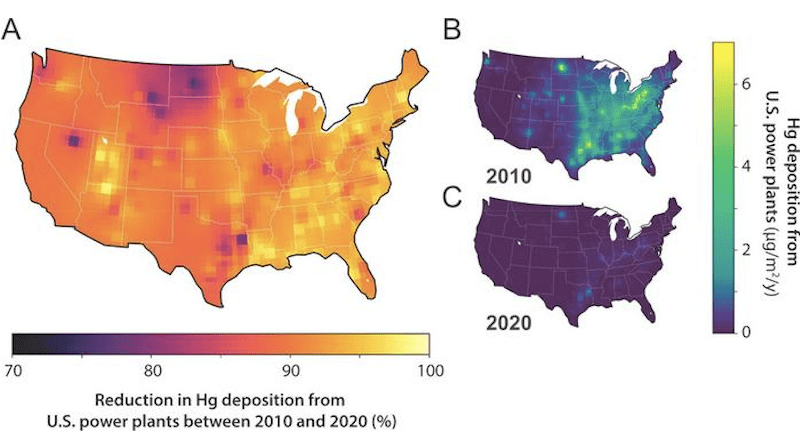Despite Major Progress Nationally, Two Mercury Emissions Hotspots Remain
Missing from partisan political debates over regulations affecting the energy sector is the stunning success of the federal government’s signature environmental laws. A prime example: the U.S. Environmental Protection Agency’s rules aimed at reducing the harmful effects of hazardous air pollutant (HAP) emissions from fossil fuel-fired power plants known as the Mercury and Air Toxics Standards, or MATS.
A new study from the Harvard John A. Paulson School of Engineering and Applied Sciences (SEAS) shows that in the decade since the standard was promulgated, the amount of mercury spewing into the atmosphere from U.S. power plants – and eventually into the ground, water, and food web – decreased by 90 percent. Mercury is a potent neurotoxicant and exposures have also been associated with increased risks of fatal heart attacks in adults.
The new paper analyzes sociodemographic disparities in mercury exposures from U.S. power plants and residual risks remaining for the most highly exposed populations. The research is published in the journal Environmental Science & Technology Letters.
Before MATS was promulgated in 2011, coal-fired power plants were the largest domestic source of dangerous mercury emissions. In 2005, coal-fired power plants accounted for 50 percent of all primary U.S. mercury emissions sources. The MATS regulation forced all power plant operators to meet the top-tier of emissions control performance standards across the country. Many operators chose to shut down coal-fired electricity generating units when the price of natural gas fell. Some switched fuel types altogether to burn natural gas, a fuel source that produces negligible mercury emissions. Of the 507 coal-fired power plants that were operating in 2010 before the MATS rules went into effect, 230 were fully retired and 62 partially retired by 2020.
“The MATS regulation is another wonderful success story linked to the Clean Air Act Amendments of 1990,” said Elsie Sunderland, Fred Kavli Professor of Environmental Chemistry and Professor of Earth and Planetary Sciences at SEAS. “This regulation has effectively eliminated most of the last remaining U.S. mercury emissions point sources, with benefits for millions of freshwater and recreational anglers across the country.”
Despite the historic national progress, two regions stand out as stubborn continuing sources of mercury emissions: Texas and North Dakota. Both states are home to power plants that burn locally mined lignite coal, which is a lower quality and less dense energy source compared to the bituminous coal that fuels plants in most other parts of the country. This means that lignite burning control standards for mercury in 2012 were less stringent than those developed for most U.S. power plants and mercury emissions remained higher than in other areas after the MATS rule was implemented.
The EPA is required to periodically evaluate whether advances in available technology merit updates to its standards. The agency has now proposed changes to MATS that would compel operators of lignite coal-burning power plants to adopt technologies that would significantly reduce their toxic emissions. These proposed more stringent standards are open for public comment until June 23, 2023.
“Our recent work suggests that strengthening the MATS rule, as proposed by the Biden Administration, would eliminate the last two remaining mercury deposition hotspots in the United States attributable to coal-fired power plants. This is an important change that will benefit vulnerable communities and indigenous groups,” said Sunderland.
The Harvard team also investigated whether the sociodemographic characteristics of people living near power plants that continued to operate in 2020 differed from those living near facilities that had retired since 2010. They found that those who continue to be exposed to dangerous mercury levels from power plant emissions tend to be poor, less educated, and from limited-English households.
“This work reinforces the lack of distributional justice in the siting of U.S pollution sources and exposures, with effects on the health of the most vulnerable individuals and communities,” said first author of the new paper Mona Dai, a PhD student in Sunderland’s Lab.

